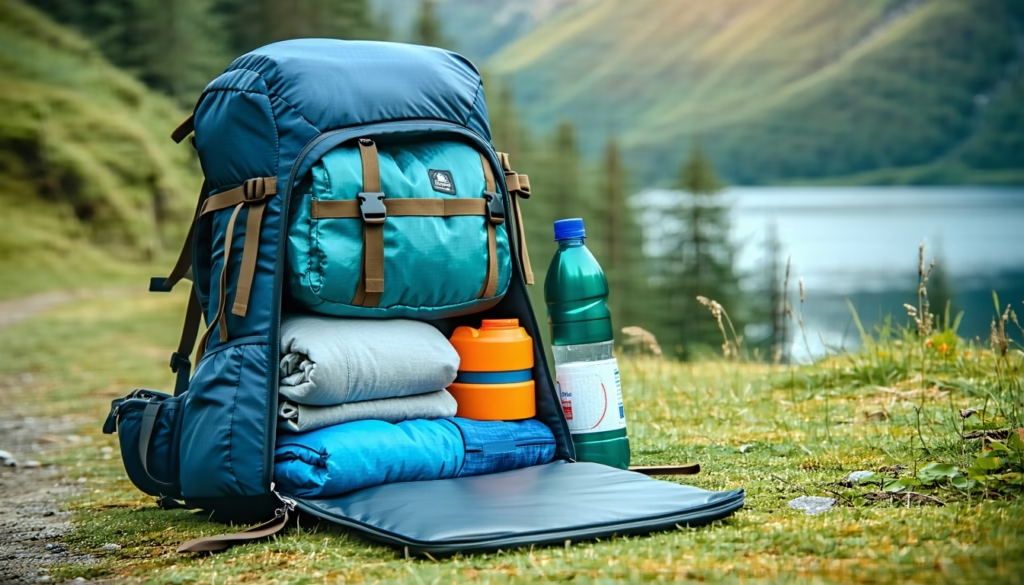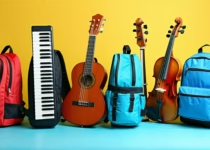Packing Techniques For Hiking Backpacks With Gear

In this guide, you’ll discover key packing techniques for hiking backpacks with gear, so you can ditch the chaos inside your bag and tackle the trail ready for anything. Hiking with a well organized pack isn’t just about saving space, it’s about comfort, safety, and having quick access to the items you need most.
Here’s what we’ll cover:
- Choosing a pack that fits your trip and your body
- Categorizing and grouping your gear efficiently
- Strategically layering items to balance weight
- Leveraging compression and attachment points
- Testing fit and making final adjustments
Let’s jump in and transform how you pack for your next hike.
Choose The Right Backpack
Unsure which pack suits your trip? Your choice of backpack sets the stage for every packing technique that follows. Aim for a pack with the right capacity—35 to 50 liters for overnight trips, or 50 to 70 liters for multi-day hikes. A pack that’s too small forces you to cram gear and lose easy access. Too big and you might end up hauling extra weight you don’t need.
Think about how you load your pack. Top loaders open from the top and are super simple for sliding gear in, while panel loaders offer zippered openings on the side and full access to your main compartment. If you prefer easy access to everything, a panel loader might be worth considering.
Fit is king when it comes to comfort. Measure your torso length before buying, and look for adjustable vertical straps on the harness. Hip belt pockets are a game changer for stashing snacks and your phone, reducing the need to take off your pack for a quick bite.
Here are the must-have backpack features:
- Frame type: internal or external support structures that fit your back shape
- Capacity: volume that matches your trip length and gear list
- Hip belt: padded, adjustable belt to transfer weight to your hips
- Load lifter straps: small straps that help pull weight closer to your body
- Pockets and compartments: easy access to snacks, water bottle, and maps
Pick a pack that feels snug but not constricting. When you trial-fit with a few pounds of gear, you get a real sense of comfort before hitting the trail.
Sort Gear Into Categories
Ever feel like your gear is a jumbled mess when you unzip your pack? Grouping items by their function makes everything easier to find on the trail. Start by dividing your gear into sleep, cook, clothing, electronics, and first aid categories. After that, break each category into subgroups based on frequency of use.
For example, pack your rain layers and snacks where you can grab them quickly, while stowing your cold-weather base layers deeper in the bag. Use color-coded stuff sacks or packing cubes to spot categories at a glance. Adding simple labels or using cubes in different colors can shave off precious minutes when daylight is fading.
Try these organizers:
- Stuff sacks for sleeping bags and pillows
- Dry bags for electronics, maps, and important documents
- Packing cubes for clothing layers and small essentials
- Zippered pouches for first aid kits and toiletries
- Separate sack for worn clothes to keep them away from clean gear
For more tips on handling bulky gear like tents and pads, check out space-saving hacks for camping backpacks and gear. Once your categories are clear, loading and unloading become seamless.
Layer Gear Strategically
Proper weight distribution keeps your pack stable and your body happy on uneven terrain. Heavy and dense items belong close to your center of gravity, while lighter, bulkier gear rides near the top for quick access.
Pack Heavy Items Low
Place your densest gear at the bottom of the main compartment so it sits low and close to your back. Think water reservoir, fuel canister, or cooking stove. Positioning these items just above your hip belt ensures your strong hip muscles carry the load, rather than your shoulders.
Arrange Midweight Gear Centrally
Midweight items like clothing layers, food bags, and your sleep system fill the pack’s belly. Compress bulky layers into packing cubes and stack them neatly around the heavier gear. If you need a refresher on cube organization, see how to use packing cubes for ultimate luggage organization.
Store Lighter Items Above
Keep items you might grab mid-day—rain jacket, snacks, first aid kit—near the top of the bag or in lid pockets. This placement saves you from pulling everything out when the weather turns or hunger strikes. A lightweight wind shell fits perfectly in an easy-access pocket.
Use Compression Accessories
A well-chosen compression accessory can reduce gear volume by up to half, giving you room for extras like a camera or extra layers. Compression sacks and packing cubes aren’t just about saving space, they also keep items snug and prevent shifting inside your pack.
Start by choosing the right size sack or cube for each category. Overstuffed cubes can be hard to compress, and tiny sacks might not fit your bulkier items. Strike a balance so you can slide your gear in without wrestling with zippers.
Consider these options:
- Compression sacks for your sleeping bag, which squeeze out trapped air
- Dry bags with roll-top seals to protect important gear from moisture
- Packing cubes to group and slightly compress socks, base layers, and underwear
- Zippered pouches for first aid kits and cooking utensils
End every compression session by tightening straps or rolling down the top until your gear can’t move. That way, nothing shifts when you’re on the move.
Utilize External Straps
Those loops, daisy chains, and lash points on your pack’s exterior are often overlooked, but they’re perfect for hauling extra gear. Strapping items outside frees up internal space and keeps odd-shaped objects secure.
Look for reinforced gear loops on both sides of the hip belt and compression straps on the sides and bottom. These features let you carry a rolled sleeping pad, tent poles, or trekking poles without sacrificing internal room. Make sure straps are snug but not so tight that they damage fabric or twist your load.
Here’s how to use them:
- Attach your rolled sleeping pad under the bottom straps for easy overnight packing
- Clip trekking poles into side daisy chains, then secure the handles at the top for stability
- Lash your tent poles or compact folding chair alongside the pack’s sides
- Fasten your helmet or climbing shoes with carabiners on the top loops
By mastering external attachments, you turn your pack into a versatile tool.
Balance Weight Evenly
Nothing throws off your stride faster than a pack that pulls more on one side. Even small imbalances can lead to shoulder pain or hip discomfort after miles of hiking.
Start by mirror-packing items across the central frame. For instance, if you have a spare fuel canister on one side, balance it with a lightweight water bottle or similar item on the other. When you tighten your hip belt and shoulder straps, lift your pack to check left-right symmetry. If one side dips, swap items or adjust placement until the load feels centered.
Follow these tips:
- Weigh bulky items ahead of time to create matching pairs
- Use side pockets for equally sized gear like stove canisters or water bottles
- Check symmetry during a quick squat and stand—any lean signals a rebalance
- Fine-tune load lifter straps to keep the weight close to your back
Balanced weight means happier knees and a steadier pace on rocky trails.
Protect Sensitive Equipment
Your camera, GPS device, or phone can be priceless on the trail, so it deserves extra care. Tossing these items loosely into the main compartment invites chaos and potential damage.
First, wrap electronics in a soft cloth or layer of clothing and then stash them in a small dry bag or padded case. This dual protection guards against bumps and moisture. For lenses or delicate sensors, consider dedicated camera inserts that fit inside your pack’s main compartment. For ideas on organizing your power banks and chargers, see how to fit tech gadgets and chargers without clutter.
Try these methods:
- Place gadgets close to your spine where the pack structure offers the best protection
- Use silica or desiccant packs in dry bags to control moisture
- Store chargers, batteries, and cables in a separate zippered pouch to avoid tangles
- Keep fragile items away from sharp objects like trekking poles or cooking gear
With a little extra planning, your sensitive gear stays safe and ready to capture every epic view.
Adjust And Test Fit
You’ve packed everything strategically, but a poor fit can ruin your hike. Take time to fine-tune the harness adjustments so the pack becomes an extension of your body.
- Loosen all straps before putting the pack on so it slides on easily
- Secure the hip belt over your hip bones, tightening it until snug but not constricting
- Pull down on the shoulder straps to eliminate gaps between your shoulders and the harness
- Fasten load lifter straps at a 45-degree angle, pulling weight closer to your torso
- Clip the sternum strap across your chest so it stabilizes the shoulder straps without pinching
- Walk, squat, and pivot—notice any hotspots or slipping and adjust straps accordingly
If you feel pressure points during your test walk, tweak each strap in small increments until the pack feels balanced and secure.
Frequently Asked Questions
How Do I Choose Backpack Size For Overnight Hikes?
Overnight hikes typically require a 35–50 liter pack, depending on your gear list and personal comfort. Measure your torso length and test-fit packs with a load similar to what you expect to carry. If you find yourself squeezing gear in or leaving items behind, try a slightly larger or more feature-rich model.
What Gear Should I Keep Easily Accessible?
Keep items you use mid-hike in external pockets or top-lid compartments—for example, rain layers, snacks, headlamps, and maps. That way, you avoid unpacking the entire bag each time you need a quick refuel or weather update. Think “grab-and-go” when assigning these spots.
Can I Use Compression Bags On The Trail?
Yes, compression bags are great for reducing bulk on the trail, especially for your sleeping bag and down jacket. Just make sure you don’t overstuff them, or the zippers can jam in cold or wet conditions. Tighten your pack’s straps after compression to lock everything in place.
How Do I Prevent Gear From Shifting Inside My Pack?
Group similar items together in cubes or sacks, and tighten your pack’s internal straps once everything is loaded. Mirror-loading and checking left-right balance helps, too. A quick test walk—complete with squats and pivots—will reveal any shifting sections you can address before stepping onto the trail.
Is It Safe To Carry Gear Externally?
Carrying items like sleeping pads, trekking poles, and tents externally is safe if you secure them properly with reinforced loops and compression straps. Keep sharp objects away from fabric, and tighten straps so gear can’t swing. If you expect rain, consider packing sensitive items in dry bags before attaching them outside.
How Often Should I Repack To Maintain Balance?
It’s a good habit to check your pack every few days or after adding any new gear (like souvenirs or extra food). Even a small shift in weight can throw off your balance. A quick repack doesn’t take long and helps you stay comfortable on the trail.
Finalize Your Packing Plan
Mastering these packing techniques transforms your backpack from a chaotic jumble into a finely tuned machine that carries your essentials with ease. By choosing the right pack, sorting gear by category, layering strategically, and using compression tools and external straps, you’ll not only save space but also distribute weight comfortably. Remember, a balanced load and a well-fitted harness mean fewer aches and more enjoyment out on the trail.
Now that you’ve got the framework, give your next pack a test run—adjust, rebalance, and adjust again until everything feels just right. Have a favorite packing hack that we didn’t cover? Share it in the comments below so we can all hike smarter and lighter.


